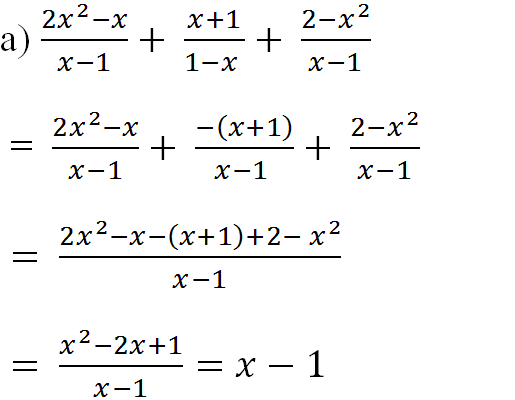
Hãy nhập câu hỏi của bạn vào đây, nếu là tài khoản VIP, bạn sẽ được ưu tiên trả lời.


- Muốn cộng hai phân thức cùng mẫu, ta cộng các tử với nhau và giữ nguyên mẫu.
- Muốn cộng hai phân thức khác mẫu, ta quy đồng mẫu thức rồi cộng các phân thức cùng mẫu vừa tìm được.
\(\dfrac{3x}{x^3-1}+\dfrac{x-1}{x^2+x+1}\)
\(=\dfrac{3x}{\left(x-1\right)\left(x^2+x+1\right)}+\dfrac{\left(x-1\right)\left(x-1\right)}{\left(x-1\right)\left(x^2+x+1\right)}\)
\(=\dfrac{3x+x^2-2x+1}{\left(x-1\right)\left(x^2+x+1\right)}\)
\(=\dfrac{x^2+x+1}{\left(x-1\right)\left(x^2+x+1\right)}\)
\(=\dfrac{1}{x-1}\)

a)\(=\dfrac{x-2+x+5}{x+3}=\dfrac{2x+3}{x+3}\)
b)ĐKXĐ: \(x+3\ne0\Leftrightarrow x\ne-3\)
a) Ta có: \(\dfrac{x-2}{x+3}+\dfrac{x+5}{x+3}\)
\(=\dfrac{x-2+\left(x+5\right)}{x+3}\)
\(=\dfrac{x-2+x+5}{x+3}\)
\(=\dfrac{2x+3}{x+3}\)
b) ĐKXĐ: \(x+3\ne0\)
hay \(x\ne-3\)

Câu 4: Không có nghĩa khi x-3=0
=>x=3
Câu 5:
\(A=\dfrac{x-3}{\left(x-3\right)\left(x+3\right)}=\dfrac{1}{x+3}\)

\(\dfrac{1}{x^2-x+1}-\dfrac{x^2+2}{x^3+1}=\dfrac{1}{x^2-x+1}-\dfrac{x^2+2}{\left(x+1\right)\left(x^2-x+1\right)}=\dfrac{x+1}{\left(x+1\right)\left(x^2-x+1\right)}-\dfrac{x^2+2}{\left(x+1\right)\left(x^2-x+1\right)}=\dfrac{x+1-x^2-2}{\left(x+1\right)\left(x^2-x+1\right)}=\dfrac{-x^2+x-1}{\left(x+1\right)\left(x^2-x+1\right)}\)

`a, a/(a-3) - 3/(a+3) = (a(a+3) - 3(a-3))/(a^2-9)`
`= (a^2+9)/(a^2-9)`
`b, 1/(2x) + 2/x^2 = x/(2x^2) + 4/(2x^2) = (x+4)/(2x^2)`
`c, 4/(x^2-1) - 2/(x^2+x) = (4x)/(x(x-1)(x+1)) - (2(x-1))/(x(x+1)(x-1))`
`= (2x+2)/(x(x-1)(x+1)`
`= 2/(x(x-1))`

ĐK: x#0; x#-1
\(\frac{x^4}{1-x}\)+ x3 + x2 + 1
= \(\frac{x^4}{1-x}\)+ \(\frac{x^3\left(1-x\right)}{1-x}\)+ \(\frac{x^2\left(1-x\right)}{1-x}\)+ \(\frac{1-x}{1-x}\)
= \(\frac{x^4+x^3-x^4+x^2-x^3+1-x}{1-x}\)
= \(\frac{x+1}{1-x}\)

Hướng dẫn:
Ta có:
+ Cộng hai phân thức
Ta có: